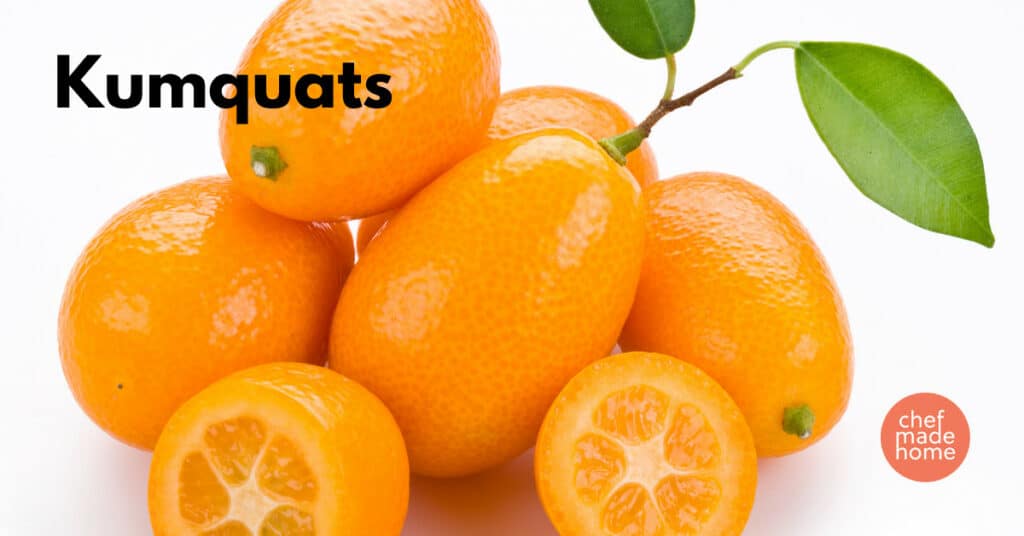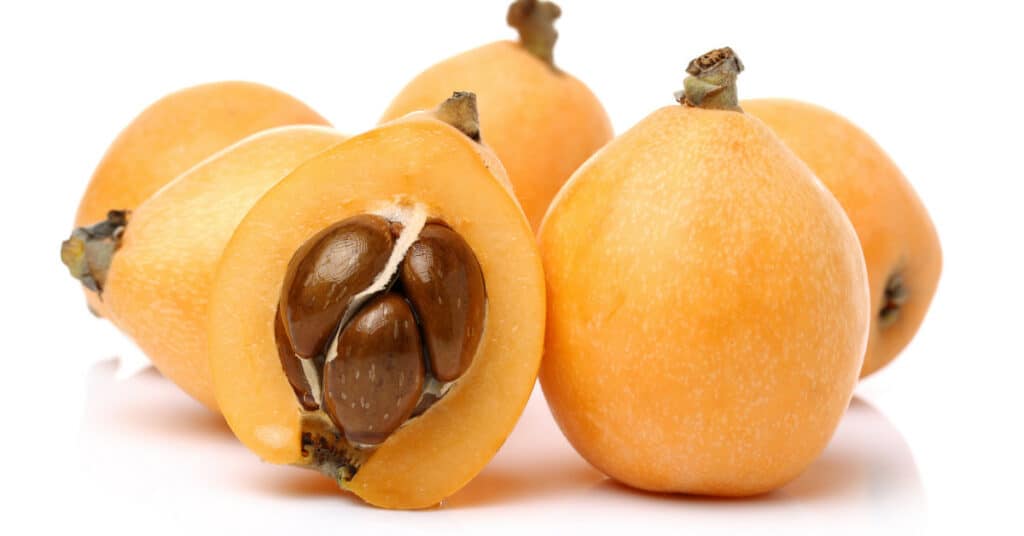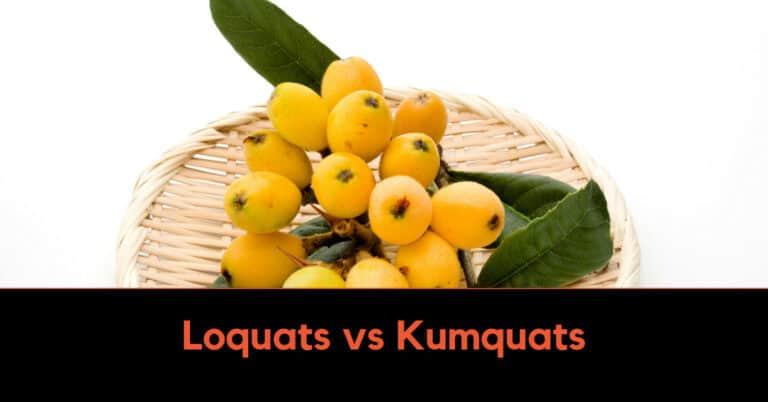SUMMARY: Loquats and kumquats are both small fruits, but they differ in terms of taste, appearance, and usage. Loquats are larger, have a sweet and tangy flavor, and are commonly eaten raw. At the same time, kumquats are small, tart, and often used for culinary purposes like marmalades and garnishes.
Is the choice between loquat and kumquat leaving you perplexed?
Look no further as we delve into these two fruits’ characteristics, tastes, and culinary uses to help you make an informed decision.
Teaser for upcoming subtopics:
- Loquat – A Delightful Fruit
- Kumquat – Small but Mighty
- Loquat vs Kumquat – The Showdown
- Choosing Between Loquat and Kumquat
Get ready for some fruity knowledge!

Loquat – A Delightful Fruit
Loquats are a delightful fruit with various appealing characteristics:
- Taste and Texture
- Loquats are known for their unique blend of sweetness and tartness, creating a refreshing and enjoyable flavor.
- The texture of a ripe loquat is similar to that of a peach, with soft and juicy flesh that melts in your mouth.
- Nutritional Benefits
- Loquats are packed with essential nutrients such as vitamins A and C, vital in maintaining a healthy immune system.
- They are also a good source of dietary fiber, aiding digestion and promoting a feeling of fullness.
- Potential Health Benefits
- Studies suggest that loquats may have antioxidant properties, helping to combat oxidative stress and inflammation in the body.
- Some research indicates that certain compounds found in loquats may have potential anti-cancer properties, though further studies are needed.
Embrace the wonderful world of loquats and explore their delightful flavors and benefits.

Kumquat – Small but Mighty
Kumquats, also known as “the little gold gems,” are small citrus fruits that pack a punch in terms of flavor and nutritional value. In this section, we will explore kumquats’ characteristics, taste and texture, and potential health benefits.
Characteristics of Kumquats
- Kumquats belong to the Rutaceae family and are native to Southeast Asia.
- These small oval or round fruits typically range from 1 to 2 inches long.
- The skin of a kumquat is edible and can be either golden orange or bright yellow, depending on the variety.
- Unlike other citrus fruits, the flesh of a kumquat is tart, while the skin offers a burst of sweet flavor.
Taste and Texture
- When you bite into a kumquat, you’ll experience a refreshing combination of sweet and tangy flavors.
- The flesh of a kumquat is firm and juicy, offering a delightful burst of citrusy goodness with each bite.
- The skin has a slightly bitter taste but balances well with the sweeter flesh, creating a unique flavor profile.
Nutritional Benefits
- Despite their small size, kumquats pack a nutritional punch.
- They are rich in essential nutrients such as vitamin C, fiber, and antioxidants.
- Vitamin C is vital in supporting the immune system and promoting collagen production for healthy skin.
- The fiber content in kumquats aids in digestion and helps regulate blood sugar levels.
- Antioxidants found in kumquats help protect the body against oxidative stress and inflammation.
Exploring the world of kumquats opens up a whole new range of flavors and possibilities. In the next section, we will compare loquats and kumquats, highlighting their distinct characteristics and culinary uses.

Loquat vs Kumquat – The Showdown
When comparing loquats and kumquats, there are notable differences in appearance, taste, and culinary uses. This section will explore how these two fruits stack up against each other, giving you a better understanding of their unique qualities.
Physical Appearance and Size
- Loquats:
- Loquats are larger fruits compared to kumquats, typically measuring 1 to 2 inches in diameter.
- They have a rounded or pear-shaped appearance, with thin, fuzzy skin ranging from yellow to orange.
- The flesh of a loquat is juicy and ranges from pale yellow to orange, with a few large seeds in the center.
- Kumquats:
- On the other hand, kumquats are much smaller and oval or round, reaching about an inch long.
- They have smooth, edible skin that can be golden orange or bright yellow.
- The flesh of a kumquat is tangy and juicy, with tiny seeds distributed throughout.
Taste, Texture, and Flavor Profiles
- Loquats:
- Loquats have a mildly sweet and slightly tangy taste that resembles a mix of peach, citrus, and apricot.
- The texture of a loquat is soft and velvety, with a pleasant juiciness that bursts in your mouth.
- The flavor profile of a loquat leans more towards sweetness, making it enjoyable as a stand-alone snack or as an addition to salads and desserts.
- Kumquats:
- Kumquats exhibit a unique flavor profile, where the sweet citrusy notes come from the flesh, and the tartness is derived from the edible peel.
- The texture of a kumquat is firm and juicy, offering a refreshing burst of tanginess in every bite.
- With their balanced sweet and tart flavors, kumquats often add zest to marmalades, chutneys, and baked goods.
Culinary Uses and Recipes
- Loquats:
- Loquats are versatile fruits that can be enjoyed differently.
- They can be eaten fresh, incorporated into fruit salads, or used as a topping for yogurt and ice cream.
- Loquats can also be cooked into jams, jellies, or pies, adding a unique touch to traditional recipes.
- Kumquats:
- Kumquats are a popular choice for creating preserves, such as kumquat marmalade, due to their tart flavor and edible peel.
- These small citrus fruits are also used as a garnish for cocktails, and their tangy taste adds a refreshing twist to various beverages.
- Incorporating kumquats into salads or savory dishes can provide a burst of citrusy flavor that enhances the overall taste profile.
Personal Insights and Opinions
- Loquats:
- Personally, I find loquats to be a delightful treat during the summer months when their juicy sweetness is at its peak.
- Their versatility in sweet and savory dishes makes them a fruit worth exploring in the culinary world.
- Kumquats:
- Kumquats, with their unique combination of sweet and tart flavors, add a lively touch to any recipe.
- I always keep a jar of homemade kumquat marmalade in my pantry to enjoy as a breakfast spread or as an accompaniment to cheese platters.
In the next section, we will dive into the factors that can help you decide between loquats and kumquats, considering various preferences and situations.

Choosing Between Loquat and Kumquat
When deciding between loquats and kumquats, there are several factors to consider. Each fruit has unique qualities and can better suit certain situations or preferences. In this section, we will discuss these factors, provide guidance on making a choice, and share tips on selecting and storing both fruits.
Factors to Consider
- Taste Preferences:
- Consider whether you prefer sweeter fruits or tangy, citrus flavors.
- If you enjoy a combination of both sweet and tart flavors, kumquats might be the better choice.
- If you lean towards a more sweet and mild taste, loquats may be more appealing.
- Culinary Uses:
- Think about the recipes or dishes you plan to create using the fruits.
- Loquats are versatile and can be used in sweet and savory recipes, making them a great all-rounder.
- Kumquats, with their tart and citrusy taste, are excellent for adding a zing to marmalades, dressings, and cocktails.
- Seasonality and Availability:
- Consider the availability of each fruit in your region and their respective growing seasons.
- Loquats are typically available during the late spring and early summer months.
- Kumquats tend to be available from late fall to early spring.
Preferences and Situations
- Snacking:
- If you enjoy snacking on juicy, sweet fruits, loquats can be a satisfying choice.
- On the other hand, if you prefer a tangy and refreshing bite, kumquats can provide a delightful snack experience.
- Preserves and Jams:
- If you prefer making preserves or jams, kumquats’ tangy flavor and edible peel make them an ideal choice.
- However, loquats can also be used in preserves, providing a sweeter and milder taste profile.
Selecting and Storing
- Loquats:
- Look for loquats that have a vibrant color and yield slight softness when gently squeezed.
- Store ripe loquats in the refrigerator for up to a week.
- If you have excess loquats can be frozen for future use.
- Kumquats:
- Choose kumquats with glossy, firm skin without any blemishes.
- Store unwashed kumquats at room temperature or refrigerate for up to two weeks.
- To prolong their shelf life, freeze whole kumquats or their sliced segments.
Decision-making between loquats and kumquats ultimately comes down to personal preference and the culinary possibilities that excite you. Experimenting with both fruits can open up a world of flavors in your kitchen.
In the final section, we will summarize the article by summarizing the key points discussed and leaving readers with a witty closing statement related to the comparison.
Key Takeaways: Loquats vs Kumquats:
This article comprehensively compares loquats and kumquats. Here are the key takeaways:
- Loquats are larger and have a distinct sweet and tangy flavor, while kumquats are smaller and boast a unique sweet-tart taste that is consumed whole.
- Both fruits offer various nutritional benefits, with loquats being a good source of vitamin A and kumquats packed with vitamin C.
- Loquats are often enjoyed fresh or incorporated into desserts and jams, while kumquats add a burst of flavor to salads, cocktails, and even savory dishes.
- When choosing between loquats and kumquats, consider personal preferences, culinary uses, and individual health needs.
- Properly selecting and storing both loquats and kumquats helps to ensure their optimal freshness and taste.
Embrace the diversity of flavors and possibilities that loquats and kumquats bring to the table, and savor the delightful experience of trying these unique fruits.
Frequently Asked Questions
When are loquats and kumquats in season?
Loquats are typically in season from late spring to early summer, while kumquats are available during the winter.
Can you eat the skin of a loquat or kumquat?
The skin of a kumquat is edible and enhances the overall flavor, while loquat skins are not commonly eaten due to their tougher texture and slightly bitter taste.
How do I know if a loquat or kumquat is ripe?
Ripe loquats should have a golden yellow color and yield to gentle pressure when squeezed. Kumquats are usually picked when fully orange and can be slightly soft.
Can I grow loquats and kumquats in my backyard?
Both loquats and kumquats can be grown in suitable climates. Loquats flourish in subtropical regions, while kumquats are more tolerant of cooler temperatures.
Are loquats and kumquats frequently used in traditional cuisines?
Loquats have a long history in traditional Chinese cuisine, where they are used in various dishes and herbal remedies. Kumquats are often employed in Southeast Asian and Mediterranean cuisines.
Are there any common misconceptions about these fruits?
One common misconception is that loquats and kumquats are the same fruit. Although they share some similarities, such as their small size, they have distinct taste profiles and characteristics.
Can I freeze loquats and kumquats for future use?
Yes, both loquats and kumquats can be frozen for later use. However, removing the seeds and peeling them before freezing is recommended for better texture and taste.
Are loquats and kumquats suitable for individuals with specific dietary needs?
Yes, loquats and kumquats can be enjoyed by individuals following various dietary regimes, including vegan, gluten-free, and low-calorie diets, due to their natural and unprocessed nature.
Are loquats and kumquats safe for consumption during pregnancy?
Loquats and kumquats are generally safe to eat during pregnancy. However, it’s always best to consult a healthcare professional to ensure they align with specific restrictions or recommendations.
Can loquats and kumquats be used in cocktails?
Absolutely! Both loquats and kumquats add flavor and visual appeal to cocktails, making them an excellent choice for mixologists and cocktail enthusiasts.

